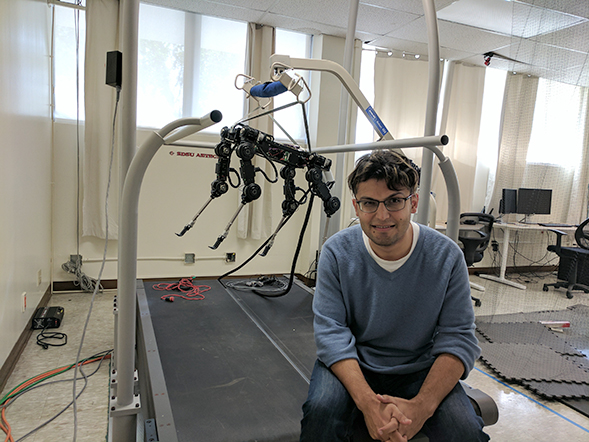A Leg Up for Prosthetics
Engineer Kaveh Akbari Hamed is working with robots to help powered prosthetic limbs walk more efficiently.

The quadruped robot suspended a few inches above a treadmill inside San Diego State University’s engineering building looks a little bit like a headless, medium-sized dog. Its spindly mechanical legs appear ready to spring into action. Officially, its name is SQ1—robotic, perfunctory—but SDSU engineer Kaveh Akbari Hamed is considering giving it a friendlier nickname. After all, it may one day help people with prosthetic legs to walk more naturally.“Right now, the simulation results are promising. We want to translate that into reality.”
“Maybe ‘Diego,’ like San Diego State. What do you think, Julian?” Hamed asks his nearby graduate student, Julian Espinoza, who nods in agreement before returning his attention to tweaking a code meant to stabilize drone flight.
Diego—or SQ1, until the nickname matter is settled—is the result of a recent three-year, $612,000 grant from the National Science Foundation awarded to Hamed, who joined SDSU in 2014. For the past 10 years, he has been working on autonomous robots but recently made the leap into the field of robotics-assisted prosthetics.
At SDSU, Hamed is using SQ1 and other robots like it to write and test local-control algorithms that make the robots walk naturally and efficiently. Whereas most approaches to robotic leg movement rely upon a centralized computer system that monitors and controls each limb, he is working on a decentralized system. Ideally, each leg would sense its own pressure and angle and respond accordingly to maintain a balanced gait.
“It’s based on the biology of animals,” Hamed said. “Studies have shown that in animals, locomotion is decentralized. Each leg monitors its own feedback and has its own controllers.”
While the brain directs higher-level functions like turning in a particular direction or stepping over a crack, the simple act of walking while keeping your balance is handled primarily by signals sent between the leg muscles and spinal cord—in other words, local control.
With centralized control systems, if something goes wrong with central control, it affects the entire system, Hamed said. The benefit of making prosthetic legs with local control is that each leg operates independently, reducing the chances of a system-wide crash. It’s also more energy efficient, meaning batteries can last longer.
“But mathematically, the problem is very complicated,” he said.
As Hamed develops these local-control algorithms at SDSU, he hands them off to his collaborator at the University of Texas at Dallas, Robert Gregg, who tests them with a powered prosthetic leg for humans. Ultimately, their goal is to imbue the prosthetic leg with a balancing algorithm that makes walking with it effortless, automatic and energy efficient.
“Right now, the simulation results are promising,” Hamed said. “We want to translate that into reality.”



